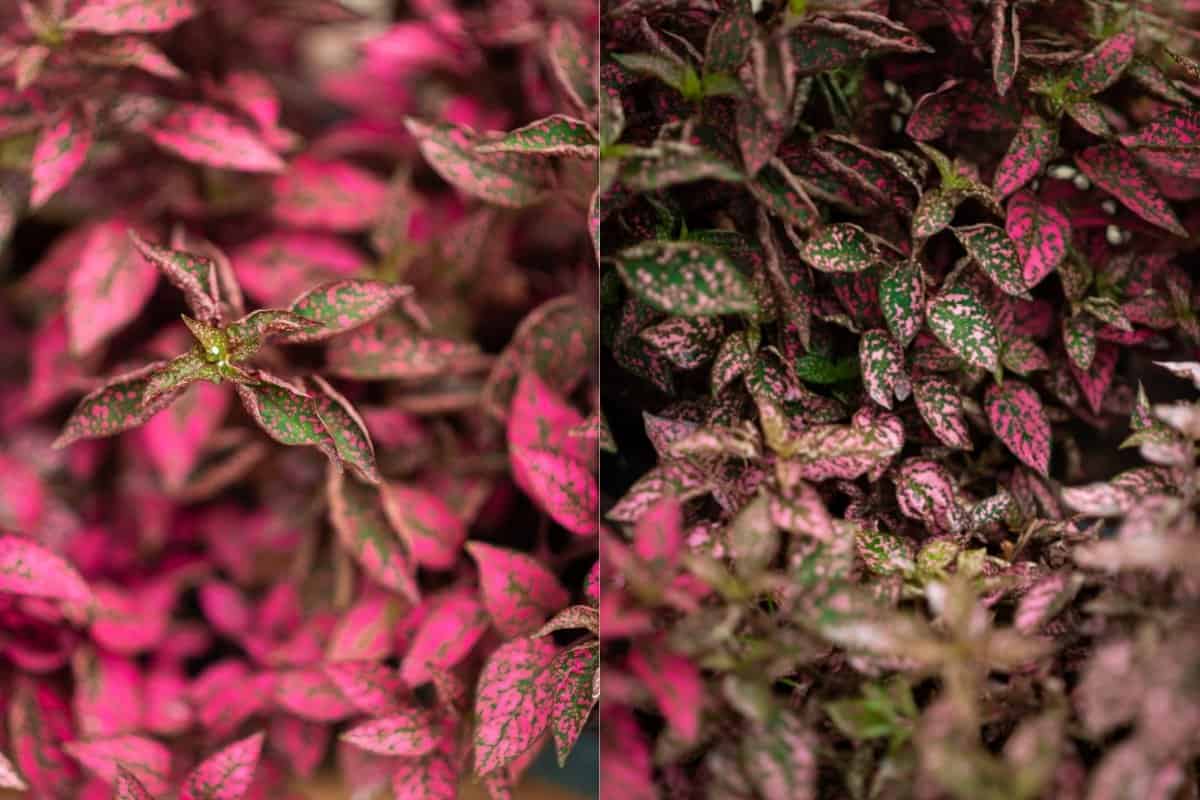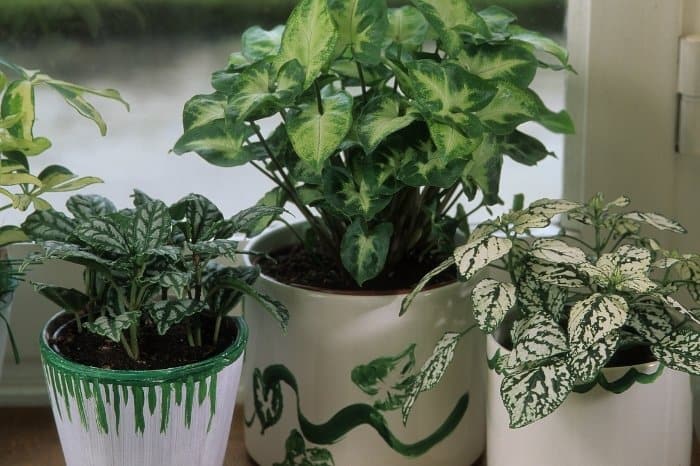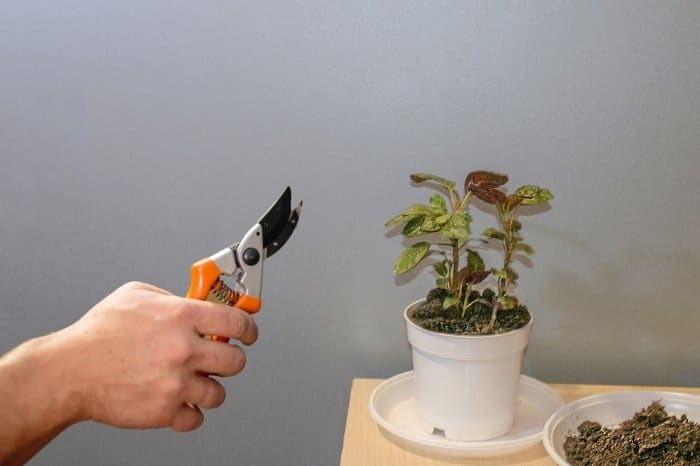Last Updated on December 14, 2021 by Cristina
Hypoestes sun or shade requirements are important to consider before planting this delicate tropical foliage plant grown as a houseplant.
Though commonly grown as an indoor plant, it has gained more popularity as an outdoor plant, brightening borders and adding to the beauty of gardens.
Originally the polka dot plant, as it is also known, is available in pink spots covering the small dark green foliage. Today, many other hybrids are available with splashes of bright red, light green, white, or even the reverse of pink with green spots. The stems and branches of the hybrid plants are also colored.
Polka Dot Plant Indoor Or Outdoor Growing
The polka dot plant is native to Madagascar and has other species from South Africa and Southeast Asia. It is a bushy plant with oval, softly downy leaves. Under perfect conditions, it grows up to 30 inches high and wide. However, most cultivars remain much smaller than this.
Polka dot plant has been grown as an indoor plant for the longest time. However, hypoestes sun or shade requirements show that it can be grown as an accent plant in gardens, window boxes, patio containers, or as a bedding plant in your garden to add some color.
This plant mixes nicely with the impatiens, caladiums, or New Guinea impatiens.
Hypoestes Sun Or Shade
Hypoestes thrive in bright filtered light while tolerating a good amount of sun. These plants obtain a better color in partial shade than full sun, but the leaves can also fade out in very low light. Polka dot plant light is essential.
This plant prefers a humid environment to thrive outdoors in the midwest during summer. When indoors during winter, it requires periodic misting to keep it well hydrated. Although it is somehow drought tolerant, it grows better with plenty of water.
Plant your hypoestes in the spring after the last frost date when the temperatures have reached 70 degrees Fahrenheit and the soil is warm enough.
Read more about Dahlia Sun Or Shade – Which One Is Best?
Hypoestes Phyllostachya Care
Polka dot plant requires good care for them to thrive. They prefer warm temperatures and humidity while growing. This plant also needs regular watering and feeding throughout the spring and fall growing season.
Hypoestes Bloom’s sporadically, especially during the summer with small pink or lilac-colored flowers on spikes. To keep the plant’s energy focused on growing its vibrant foliage pinch of this flower spikes immediately they are spent.
Provide Enough Light
When growing outdoors hypoestes require a sport that has some shade. Pick an ideal location that does not receive too much sun or else the foliage colors will fade affecting the plant ornamental value.
When growing them indoors bright indirect light is ideal, such as from a South or east-facing window.
Rich Well-draining Soil
Provide organically rich soil with proper drainage for your polka dot plants. An all-purpose organic potting mix is suitable for these plants. Mix together some perlite or pumice with soil to improve its drainage.
Water Them Moderately
Polka dot plants require a moderate amount of water in the soil at all times. Do not allow your plants to get completely dry as this can cause your foliage to wilt and make the plants struggle to survive. When watering, avoid getting the soil too soggy as it could cause root rot and kill the plant.
Plants growing in pots requires more frequent watering than garden-grown plants. Reduce your watering slightly in the winter, resuming your routine when the growth picks up again in the spring.
Mother Earth Terracraft Potting Soil, All Purpose Potting Soil For All Plants
Temperature And Humidity
Polka dot plants thrive in the USDA growing zones 10 and 11. They prefer temperatures data between 70 to 80 degrees Fahrenheit. In the spring plant, your polka dots plants outside after the threat of frost have passed and brought them inside if you plan to overwinter them before the first date of frost in the fall.
This plant prefers humid conditions with a minimum of 50%. If you need to raise the humidity, mist the plant leaves.
Fertilizing
Feed your plants with an organic fertilizer once a month for houseplants and outdoor plants during the warm season. These plants are heavy feeders and require a mix of compost in the soil each spring if planted in the garden.
Pruning
Polka dot plants tend to get long and leggy so you will need to prune them to keep them in good shape. Get a pair of clean sharp scissors or pruning shears to keep the plant from growing leggy. To promote a bushier look, pinch or cut back the top 2 leaves on each stem every week. Actively trimming can help the plant grow healthier and more vigorous.
To extend the growing season of your polka dot plant it is critical to clip your flowers when they start appearing. Please note that the flowers are not as ornamental as the leaves. As soon as the plant finishes flowering it enters a dormancy stage and dies off.
Overwintering
This plant is a tropical plant that does not survive frosty weather. Before the frost begins you can cut the stems from the plant and root them indoors in a small pot to keep them growing as an indoor plant. If you keep them indoors in a container, choose an ideal location that gets bright light or sun. In the coming spring, you can replant them in the garden after the threat of frost is over.
Conclusion
The hypoestes sun or shade argument is clarified in the above article creating a garden with the best conditions for this plant to thrive. Growing this ornamental plant is easy and its maintenance is low.
Polka dot plants are known as aggressive and problematic in Australia. However, in the US, they are not invasive and are safe to grow. Whether you choose to grow the hybrid or the traditional ones, you will still attain the beauty you want to see in your garden.
you can’t afford to forfeit the beauty of these leaves. planting the polka dot plant ensures you get a perfect landscape that you marvel at daily.
And what’s even better is the fact that you have the knowledge of how to plant and take care of these plants.
Caroline is a gardener who loves to get down to the nitty–gritty of gardening. She proudly proclaims herself as a ‘dirt worshipper‘ and can often be found deep in the garden, covered in soil and singing to her plants. As a self–proclaimed ‘plant whisperer‘, Caroline believes that plants need love and attention just like any other living thing, and she loves to give them both. When she‘s not tending to her garden, you can often find her researching the latest gardening trends, or teaching others how to make their gardens thrive





